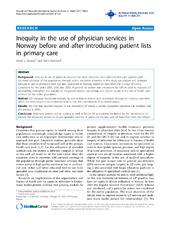Inequity in the use of physician services in Norway before and after introducing patient lists in primary care
Peer reviewed, Journal article
Published version
Permanent lenke
https://hdl.handle.net/1956/5567Utgivelsesdato
2011-06-15Metadata
Vis full innførselSamlinger
- Department of Economics [288]
Originalversjon
https://doi.org/10.1186/1475-9276-10-25Sammendrag
Background: Inequity in use of physician services has been detected even within health care systems withuniversal coverage of the population through public insurance schemes. In this study we analyse and compareinequity in use of physician visits (GP and specialists) in Norway based on data from the Surveys of LivingConditions for the years 2000, 2002 and 2005. A patient list system was introduced for GPs in 2001 to improve GPaccessibility, strengthen the stability of the patient-doctor relationship and ensure equity in the use of health careservices for the entire population.Method: We measure horizontal inequity by concentration indices and investigate changes in inequity over timewhen decomposing the concentration indices into the contribution of its determinants.Results: We find that pro-rich inequity in the probability of seeing a private outpatient specialist has declined, butstill existed in 2005.Conclusion: Improved patient-doctor stability as well as better GP accessibility facilitated by the introduction ofpatient lists improved access to private specialist services. In particular the less well off benefited from this reform.

